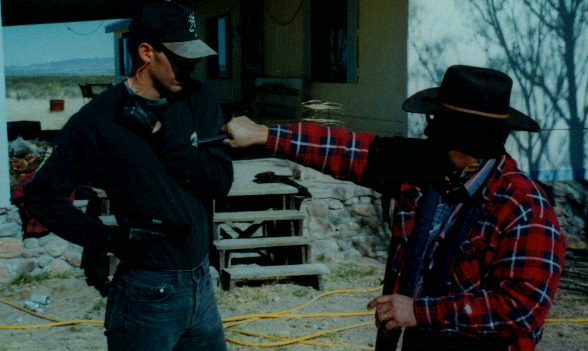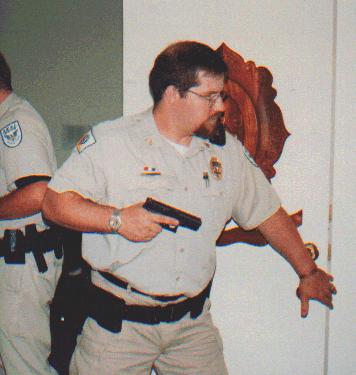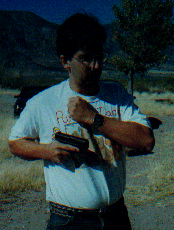From its
earliest roots, the primary objective to winning a gunfight, be it in
an F15 Strike Eagle or between
desperadoes, has been to get your weapon aimed at your opponent as quickly
as possible. While it seems
that Hollywood made a big deal out of Matt Dillon firing from the hip,
and really, probably everyone
reading this practiced the same feat as a kid, the concept was just as
applicable then as it is now. But,
before anyone gets to thinking that I’m endorsing point shooting,
I’m not. Although I’ve practiced it, like
most people I have never been worth a damn at it beyond three yards. Granted,
I have witnessed people
who were uncannily accurate at it out to ten or more yards. What Hollywood
never seemed to grasp was
that the classic quick draw stance was something used when an opponent
was at arms reach, not squared
off at twenty paces.
Death in
a western-era saloon (or the streets of modern-day Chicago for that matter)
was not about the
courage to step out into the center of the street for a fair fight. More
often than not it was about one drunk,
pissed off cowboy spontaneously shooting another drunk, pissed off cowboy
just as soon as his gun cleared
leather. Frequently the shot came from so close that the victim was clearly
marked by powder burns.
What I’m
talking about here is known currently as the speed rock. Sure, most of
the famous gunfighters
who lived past thirty were known to draw, go to an offhand stance and
use sighted fire to stop their
adversary. But romanticizing aside, most of the gunfights of the Old West
were between nobodies in heat-
of-the-moment altercations that occurred at contact distance where the
winner was the cowboy or lawman
who could get his 1860 Army upholstered and leveled the fastest. No finesse,
just shoot the thing before
the other guy gets his
out, too.
The speed
rock gained new use in the late fifties and early sixties with the competitive
quick draw fad.
Because of the simple requirements, shooters refined this sport far beyond
practical (or historical) use in
the name of winning. Whatever could be done to draw and bring your weapon
to bear was tried. Low-slung
metal-reinforced tie-down holsters, half pound trigger jobs, short barrels,
and even peculiar body angles
were employed to shave off every last nanosecond. But at its heart, competitive
quick draw was all about
a shooter getting in the first shot, accuracy be damned!
Eventually
the Matt Dillon fad faded and most police agencies that had used any type
of point shooting
began to return to various forms of aimed fire as the Weaver stance gained
following. Oddly enough
though, reexamining the average statistical gunfight or assault showed
more and more that they occurred
at incredibly close range. At the same time, police agencies, through
collective data, were realizing that
two of the biggest killers of peace officers were the high speed pursuit
and officers who were killed with
their own weapons. The buzzphrase for the decade became "Weapons
retention."

As seen
here, the weak arm is pulled back against the body to get it out of the
fire zone as well as providing
shielding to your upper chest cavity. The strong hand and weapon are rotated
to the firing position as soon as the
muzzle clears leather. Use of a standard interview stance will put the
strong side farthest from the attacker. This
move should be done at a full retreat. At this range you are only exchanging
wounds, put some distance between
you and your attacker while those bullets soak in.
schools. Designed to allow a shooter to draw a weapon from a strongside holster, rotate it to firing position
as soon as it cleared leather, and fire while keeping the weapon relatively safe from a gun grab, the Speed
rock stance was reborn.
While many
professionals had long ago (my father switched in the early sixties) taken
to carrying autos,
most police and security still clung to their revolvers. But as times
changed and Hollywood made high
capacity autos seem almost magical, agencies began to switch over to magazine
fed weapons. Where this
caused an evolutionary change to occur in the speed rock was in the fact
that the trusty revolvers of the
frontier would feed reliably regardless of how they were held so long
as you pulled the trigger.
But now we
had autos that were often sensitive to limp wristing. Every 1911 or clone
has varying degrees
of sensitivity, but compact weapons like the Detonics 45 and later the
Glock subcompacts absolutely
disliked being fired from a true speed rock. Not only that, many shooters
found they had trouble aligning
their weapon on both a horizontal and vertical axis. The stance solved
a few problems, but created a few
more.

